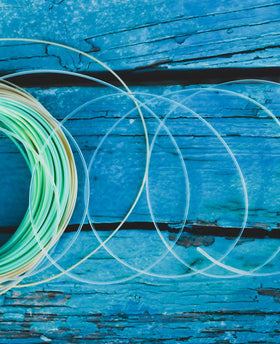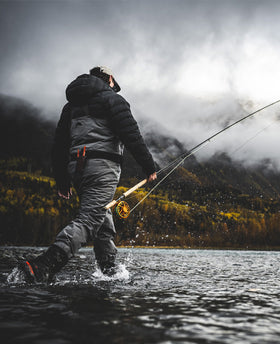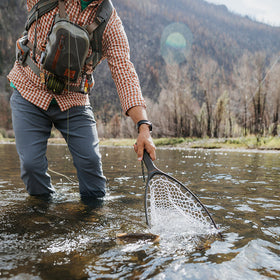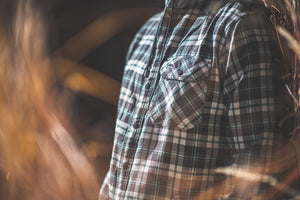
Winter Floating and Techniques

The first sign of winter pushes us to hang up the waders, cover the boat, and dust off the skis until warmer weather returns. Although this may be true for most anglers, the few that tough out the numb fingers and the frozen guides can have some very productive days on the river.
Winter Floating and Techniques
The first sign of winter pushes us to hang up the waders, cover the boat, and dust off the skis until warmer weather returns. Although this may be true for most anglers, the few that tough out the numb fingers and the frozen guides can have some very productive days on the river.

Winter Flow
Before diving into our techniques, we must take a moment to talk about the dangers of floating in the winter. Besides the basic precautions taken in the warmer months, there is now added danger including winter flows and cold temperatures. What makes winter flows such a danger is how low they can be. The normal CFS (Cubic Feet per. Second) in the summer can be anywhere from 300-500% larger than it is in the winter.

This figure above is the current winter flows for a popular river in Western Colorado.

The chart above is the flow during post run off on the same river in June. The river is anywhere from 400-600% higher during this time.
With that said, the normal lines you'd take in higher flows can drastically change and new obstructions can appear. So if it's your first time on the river during the winter months, take a friend that has floated that stretch during those flows and if that's not an option, take extra precaution and scout out any rapid or line that makes you uncomfortable.
Safety and Hypothermia
Another thing to keep in mind is the water temperature on the day you’re planning to get out on the water. The risk of hypothermia after falling into the water this time of year is super high. Most times the water temperature is sitting anywhere between 32.5 - 40°F and if an accident occurs where an individual is submerged, it only takes 15-30 min. for exhaustion and unconsciousness to set in and their expected survival time if untreated is 30-60 min. The best way to mitigate that risk is having a dry bag in the boat with a dry change of clothes, reflective emergency blanket, and fire starter kit. These items can get someone warm/dry quickly and prolong any survival time until you are safe. None of these precautions are to be taken lightly, but also don’t let it deter you from enjoying some of the best fishing of the year. We just want everyone to be safe and prepared for any emergency or accident that can occur out on the water. With the all loved safety brief over with, we can now talk about the effective way to plan our winter float.

Picking a Day and Timing
After getting your crew together, you want to plan a day with the best weather conditions. Usually finding a gap where the low temperature is in the 20s and the high is somewhere in the upper 30s. Once the day is picked, shoot for a start time around 9-10am, because most times you will have some ice/slush floating down river early in the morning. We also want the water temp to climb as much as possible so we’re effectively floating during the best feeding window. Picking days during these weather gaps and timing windows can ultimately make or break your days, so be extra picky and pay attention to the weather patterns.
Technique
Moving onto rigging, having both a streamer and nymph stick in the boat is ideal, but not required. An effective nymph rig is usually constructed of three flies on 4x or 5x tippet, two bigger attractor patterns (Egg, Worm, or Leech) and one pattern that represents a smaller midge, baetis, or stonefly nymph (Zebra Midge, Juju Baetis, or Micro Stone). For depth I recommend starting deep, because fish have a super low metabolism and energy level in the winter. They are in the lower column where they can expel little to no energy while effectively feeding. Some may move up in the column later in the day when water temperatures creep closer to 40°F, but more times than not, they are stuck to the bottom of the river. Areas you should target are the slow deeper pools and eddies, but don't overlook the faster deep runs as well. Oftentimes the bigger fish that can afford to expel more energy will call these runs home this time of year. Places to avoid should be shallow riffles, fast pocket water, and slower shallow runs on really cold/cloudy days. Remember this is fishing though, so never fully disregard water that gives you that fishy feeling, it could pay off for you.
Streamer Rig Setup
On too setting up a streamer rig, I recommend a short leader paired with a heavy sink tip line (the Scientific Anglers Sonar Titan Sink Tip 6 IPS is my favorite). For the leader, 1 foot section of 25lba butt material, to a 40lbs micro swivel, then off the swivel attach a 1.5 foot section of 0x fluorocarbon, then your streamer. Streamer choice is fully dependent on water clarity and the amount of sunlight on that day. I usually go by the old rule of “bright day bright fly, dark day dark fly”and then cycle through my colors accordingly, but in the winter I usually always start with brighter colors for attraction. When actually fishing a streamer, you should target slower areas like tailouts, eddies, slow channels, and cover with big pillows above and below them. For the retrieval side of things, go for slow lethargic movements and even a dead drift on occasion, because baitfish are also sluggish this time of year. If you experience a short strike at any time, don’t increase the action of the fly and let it dead drift for a second, they will often assume it's stunned and come around for a second swipe. With that said, we know streamer fishing can be a low numbers game, so don’t be too discouraged because the only fish you poke could be one for the record books.
To close up our discussion on winter floats, we want to address the use in moving when fishing is slow. When our average winter put-in time is at 10AM and the sun is setting earlier in the late afternoon, timing our float is important. When 12 hour floats are reduced by half, having the sense to move when fishing is slow can be your best friend. If you find that your favorite and most productive run isn’t producing, remove your attachment and move on to the next one. A day can be ruined by lapping one run early in the float before the warmest part of the day has been reached. Then having to rush through other productive runs just to make it to the take-out by dark. So once you find those few runs or holes that are producing fish more than others, fish it out until it slows down and then move to continue the timing of your float. It's never a good thing when you have to float the last quarter mile of a river in the dark, especially in the winter...

Now that you have a great guide for winter floats, put down those skis and get out there to enjoy some of the best fishing season that Colorado has to offer.
We are beginning to fill out our calendar for pre-runoff fishing dates so act now to secure your early season float dates. Our primary floating season begins March 1st (which is just a little more than a month away) so act now to get on the books. Keep in mind that our winter and early spring float trip bookings are subject to change based on river, road, and fishing conditions. Call us with any questions or concerns you might have!





Leave a comment